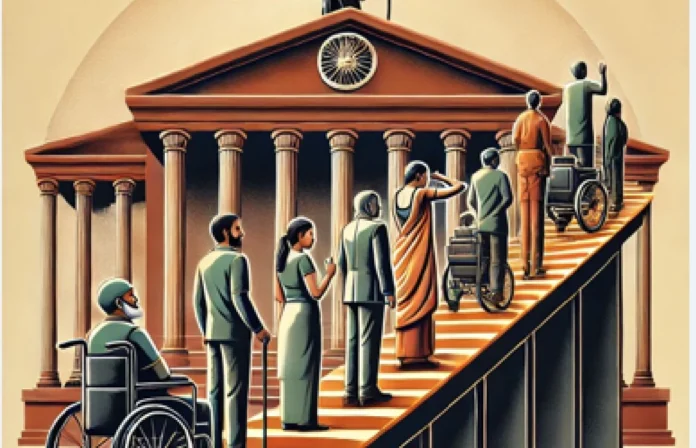By Binny Yadav
In a powerful affirmation of equality, the Supreme Court has ruled that no individual can be denied recruitment into judicial services solely because of their physical disability. This landmark judgment, delivered by a bench comprising Justices JB Pardiwala and R Mahadevan, emerged from the Court’s suo motu intervention addressing systemic discrimination against persons with disabilities (PwDs) in public employment.
This ruling underscores a vital truth: enacting laws alone is insufficient to ensure equality. It highlights the urgent need to confront systemic inefficiencies and institutional barriers that hinder the implementation of disability rights laws.
Despite the 2019 Rights of Persons with Disabilities (RPwD) Act, which mandates four percent reservation in government jobs for PwDs, a significant number of these posts remain unfilled, exposing the gap between policy and practice.
According to the 2011 Census, nearly 26.8 million Indians—or 2.21 percent of the population—live with some form of disability. Despite legal safeguards, their representation in public sector jobs remains alarmingly low. Studies show that inaccessible recruitment processes, institutional biases, and inadequate accommodations contribute significantly to this exclusion.
The Judgment And Its Core Premise
The Supreme Court intervened in response to Rule 6A of the Madhya Pradesh Services Examination (Recruitment and Conditions of Services) Rules, 1994, which effectively restricted the recruitment of PwDs in judicial services.
In striking down these restrictions, the apex court emphasized that any form of discrimination—direct or indirect—against PwDs is unconstitutional. The ruling firmly asserted that equality cannot be achieved if structural and procedural barriers continue to exclude marginalized groups.
The Court further highlighted that restrictive examination formats, procedural hurdles, and discriminatory fitness criteria disproportionately impact PwDs and violate their constitutional rights. The judgment aligns with India’s commitments under both domestic law and international obligations such as the United Nations Convention on the Rights of Persons with Disabilities (UNCRPD).
A Shift Towards Substantive Equality
At the heart of this ruling lies the principle of substantive equality—which goes beyond prohibiting overt discrimination. The judgment mandates that the State actively create a level playing field by accommodating the diverse needs of PwDs.
This pivotal shift requires authorities to reassess examination structures, eligibility criteria, and recruitment mechanisms to ensure greater accessibility. The apex court’s directive makes it clear that disability must not be treated as an automatic disqualification, but rather as a condition requiring reasonable accommodation.
Legal And Social Implications
The ruling has far-reaching consequences: Legally, it sets a precedent for dismantling discriminatory recruitment policies in other sectors, ensuring greater accountability in implementing disability rights.
Socially, the judgment challenges long-standing biases that equate disability with incapacity. By ensuring inclusivity in the judiciary, the ruling not only opens career paths for PwDs, but also strengthens the justice system by fostering diversity in its perspectives.
Challenges Ahead
While the judgment is a progressive step, its success hinges on effective implementation. The key challenges include:
- Compliance at the state level: Public service commissions must overhaul outdated recruitment processes that perpetuate exclusion.
- Infrastructure gaps: Accessible courtrooms, digital accommodations, and suitable workplace modifications must become a priority.
- Attitudinal barriers: Deep-seated biases against disabled candidates remain a significant hurdle. The National Centre for Promotion of Employment for Disabled People (NCPEDP) has consistently reported that many employers unfairly perceive PwDs as less capable.
To overcome these challenges, the ruling must be accompanied by sustained advocacy, awareness campaigns, and proactive hiring policies that prioritize inclusion.
A Watershed Moment
The onus now lies on lawmakers, recruiters, and society at large to build an inclusive system where disability is seen not as a barrier, but as a dimension of diversity that enriches institutions.
Key Data On Disability And Employment In India
- Total PwD population: 26.8 million (2011 Census).
- Employment rate of PwDs in government jobs: Less than 1 percent.
- 2019 RPwD Act: Mandates four percent reservation in government jobs.
- Unfilled reserved positions: Over 50 percent of PwD quota seats remain vacant.
- Key barriers: Inaccessible recruitment processes, institutional biases, lack of accommodations.
Judicial Rejections Due To Disabilities
- Visually impaired candidates denied selection due to inaccessible examination formats.
- Orthopedically challenged individuals disqualified based on arbitrary medical fitness criteria.
- Hearing-impaired applicants excluded due to the absence of sign language interpreters.
- Candidates with neurological disabilities facing systemic bias in cognitive ability assessments.
—The writer is a New Delhi-based journalist, lawyer and trained mediator


